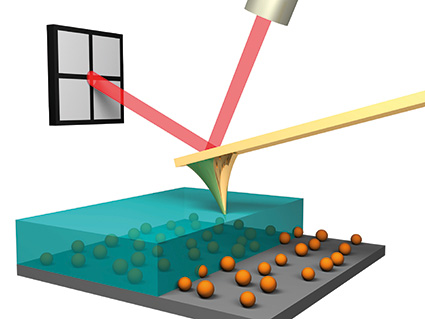(molecular nanoelectronics)
Molecular nanoelectronics and modern electrical molecular simulation techniques to a general framework for the interpretation of AFM images
Researcher and author: Dr. ( Afshin Rashid)
Note: In nanotechnology, from modern techniques of molecular simulation to a general framework for the interpretation of AFM images, especially the analysis of atomic mechanisms that determine the force changes that the microscope measures and the contrast of the image, produces.
The recent advent of high-resolution imaging and force spectroscopy using atomic force microscopy (AFM) in organic and inorganic solutions opens the way to imaging a wide variety of surfaces and their solvent structure. However, to take full advantage of the high resolution and provide significant new analytical capability, a detailed understanding of the background contrast mechanisms that lead to atomic and molecular resolution is critical. Without a theory that connects the measured force to atomic models of the surface and tip of the microscope, the information that can be distilled from these measurements is limited. Molecular dynamics simulations show that the forces acting on the microscope tip result from the direct interaction between a tip and a surface and are entirely due to the structure of water around the tip and surface. The observed force depends on a tip structure, and the balance is between the mainly repulsive potential energy changes as the tip approaches the surface and the entropic increase, which is sterically prevented from occupying sites near the tip and the water surface. Understanding the interplay of these various components that contribute to force microscopy measurements is critical to the interpretation of high-resolution images of solution interfaces.
Atomic force microscope (AFM) is one of the best tools for imaging, measuring and manipulating matter at the nano level, and actually seeing atoms and molecular bonds up close. This technique produces images that look a bit like a sound player. An atomic-scale needle at the end of the cantilever arm scans the sample and moves up and down according to the shape and electronic properties of the surface. Measuring and recording that deviation produces a three-dimensional representation of the sample molecules.The atomic force microscope uses a sharp probe that moves on the surface of the sample under investigation. In the case of the atomic force microscope, there is a tip on the (lever) that bends due to the force between the sample and the tip. By bending the cantilever, the reflection of the laser light is moved on the optical detector. In this way, the displacement of the tip of the cantilever can be measured. Since the cantilever follows Hooke's law in small displacements, the interaction force between the tip and the sample surface can be obtained from the displacement of the cantilever. And from the force between the atoms of the surface of the sample and the probe, the distance between the tip and the surface of the sample, or the height of that part of the sample, can be obtained. The movement of the probe on the sample is done by a very precise positioning device.
Conclusion :
In nanotechnology, they develop from modern molecular simulation techniques to a general framework for interpreting AFM images, particularly the analysis of the atomic mechanisms that produce the force changes that the microscope measures and determine the image contrast. slow
Researcher and author: Dr. ( Afshin Rashid)
Specialized doctorate in nano-microelectronics




